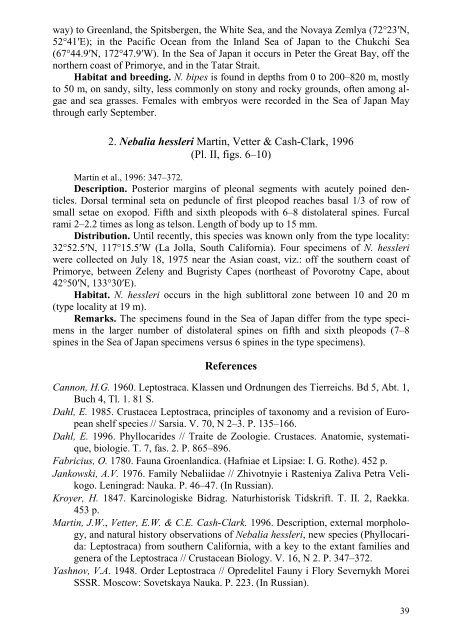биота российских вод японского моря - Materials of Alexey Shipunov
биота российских вод японского моря - Materials of Alexey Shipunov
биота российских вод японского моря - Materials of Alexey Shipunov
You also want an ePaper? Increase the reach of your titles
YUMPU automatically turns print PDFs into web optimized ePapers that Google loves.
way) to Greenland, the Spitsbergen, the White Sea, and the Novaya Zemlya (72°23′N,52°41′E); in the Pacific Ocean from the Inland Sea <strong>of</strong> Japan to the Chukchi Sea(67°44.9′N, 172°47.9′W). In the Sea <strong>of</strong> Japan it occurs in Peter the Great Bay, <strong>of</strong>f thenorthern coast <strong>of</strong> Primorye, and in the Tatar Strait.Habitat and breeding. N. bipes is found in depths from 0 to 200–820 m, mostlyto 50 m, on sandy, silty, less commonly on stony and rocky grounds, <strong>of</strong>ten among algaeand sea grasses. Females with embryos were recorded in the Sea <strong>of</strong> Japan Maythrough early September.2. Nebalia hessleri Martin, Vetter & Cash-Clark, 1996(Pl. II, figs. 6–10)Martin et al., 1996: 347–372.Description. Posterior margins <strong>of</strong> pleonal segments with acutely poined denticles.Dorsal terminal seta on peduncle <strong>of</strong> first pleopod reaches basal 1/3 <strong>of</strong> row <strong>of</strong>small setae on exopod. Fifth and sixth pleopods with 6–8 distolateral spines. Furcalrami 2–2.2 times as long as telson. Length <strong>of</strong> body up to 15 mm.Distribution. Until recently, this species was known only from the type locality:32°52.5′N, 117°15.5′W (La Jolla, South California). Four specimens <strong>of</strong> N. hessleriwere collected on July 18, 1975 near the Asian coast, viz.: <strong>of</strong>f the southern coast <strong>of</strong>Primorye, between Zeleny and Bugristy Capes (northeast <strong>of</strong> Povorotny Cape, about42°50′N, 133°30′E).Habitat. N. hessleri occurs in the high sublittoral zone between 10 and 20 m(type locality at 19 m).Remarks. The specimens found in the Sea <strong>of</strong> Japan differ from the type specimensin the larger number <strong>of</strong> distolateral spines on fifth and sixth pleopods (7–8spines in the Sea <strong>of</strong> Japan specimens versus 6 spines in the type specimens).ReferencesCannon, H.G. 1960. Leptostraca. Klassen und Ordnungen des Tierreichs. Bd 5, Abt. 1,Buch 4, Tl. 1. 81 S.Dahl, E. 1985. Crustacea Leptostraca, principles <strong>of</strong> taxonomy and a revision <strong>of</strong> Europeanshelf species // Sarsia. V. 70, N 2–3. P. 135–166.Dahl, E. 1996. Phyllocarides // Traite de Zoologie. Crustaces. Anatomie, systematique,biologie. T. 7, fas. 2. P. 865–896.Fabriсius, O. 1780. Fauna Groenlandica. (Hafniae et Lipsiae: I. G. Rothe). 452 p.Jankowski, A.V. 1976. Family Nebaliidae // Zhivotnyie i Rasteniya Zaliva Petra Velikogo.Leningrad: Nauka. P. 46–47. (In Russian).Kroyer, H. 1847. Karcinologiske Bidrag. Naturhistorisk Tidskrift. T. II. 2, Raekka.453 p.Martin, J.W., Vetter, E.W. & C.E. Cash-Clark. 1996. Description, external morphology,and natural history observations <strong>of</strong> Nebalia hessleri, new species (Phyllocarida:Leptostraca) from southern California, with a key to the extant families andgenera <strong>of</strong> the Leptostraca // Crustacean Biology. V. 16, N 2. P. 347–372.Yashnov, V.A. 1948. Order Leptostraca // Opredelitel Fauny i Flory Severnykh MoreiSSSR. Moscow: Sovetskaya Nauka. P. 223. (In Russian).39












